South West England Edge Tools
With my move to Devon, I'm staring to take more of an interest in South West edge tool makers, and local pattern tools. Devon and Somerset had several edge tool makers, and as well as supplying the agricultural and forestry markets these also tended to serve the mining and quarrying industries.
One maker, A. Morris & Sons of Dunsford in Devon, was still manufacturing edge tools until recently. Among the better known of the rest, Fussells (comprising James, Isaac and John in 1882) of Mells and Nunney, Somerset, became part of Isaac Nash in 1894. Finch Bros. of Sticklepath, Devon, closed in 1960, after a roof collapsed. Knapman of Hill Mill, Harberton near Totnes, closed in 1954, but tools from all these makers are still in use here and there.
The South Western edge tool hook types are distinctive, and tend to have a more pronounced curved beak or nose than most others, often ending in a blunt, cropped end. Another common feature is a notch in the blade just by the handle. This feature is often considered a mystery:- why is it there, how did it originate? The only light I can throw on this is that a few 20th C photographs show hedgers using a leather guard or boot (sometimes literally an old item of footwear) around the hook's handle, secured through the toe at the notch, and at the boot's heel with a ring on the end of the hook's tang - which tends to explain the ring as a feature too. For a good example see page 2 of Devon Hedges - details on my Reading page.
Note that in the images below many of the tools have new ash handles fitted, as older billhooks that I find almost always seem to have missing/very decayed/completely inappropriate handles. Perhaps not surprising for tools that may be 100 years old. Replacement handles are based on traditional forms, or catalogue images.
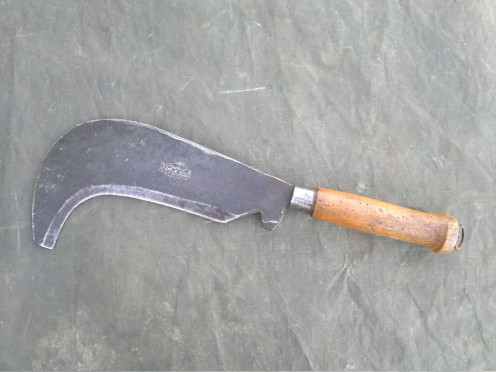
A. Morris & Sons of Dunsford, Devon. A fairly typical Devon half turn billhook in shape. Original handle, with ring at the end. Probably mid 20th C.
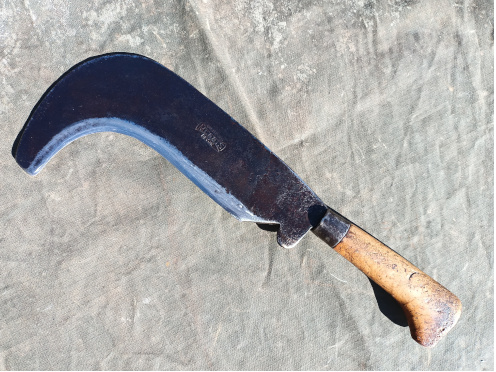
A. Morris & Sons of Dunsford, Devon. The same tool was also available with a caulked handle.
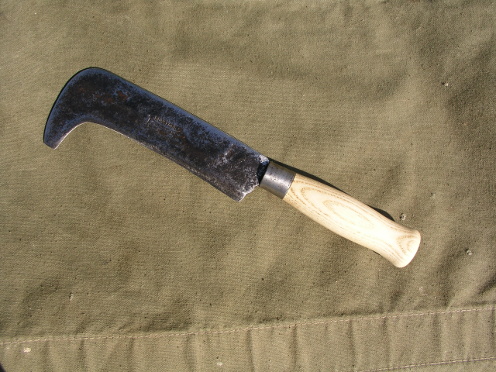
A. Morris & Sons of Dunsford, Devon. Devon pattern spar hook.
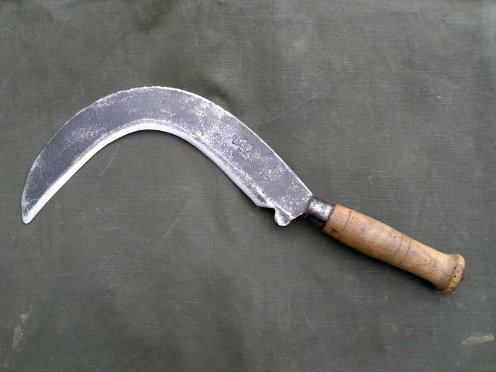
A. Morris & Sons of Dunsford, Devon. Browse/gorse/bramble type hook, original handle with ring.
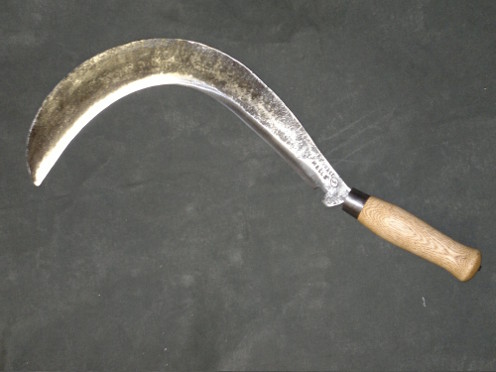
James Fussell, Mells, Somerset. Marked "Mells", but from the era of the Nash takeover (late 19th C), so the place of manufacture almost certainly Nash at Stourbridge. This is a Gorse, Furze, Bramble, Trimming or Browse hook - catalogues use many terms for this sort of tool. It is a little unusual as it is "dished" (i.e. the blade isn't flat). The tools is wider and heavier than a Grass/Fagging/Bagging Hook (which are on the face of it similar in shape) and so is good for cutting heavier material. My understanding is that the name of the tool may have originated from the old practice of cutting green leafy material from hedges as animal fodder, i.e. browse. Gorse (Furze) was considered particularly good browse, and was ground up prior to feeding. Gorse is now known to be rich in protien. I've also heard hedgers talk of "browsing out" a hedge as the initial clearing out of excess growth. This is not a shape of hook that is used much any more, I feel. Finely forged, wrought iron with applied steel bit. Late 19th C.
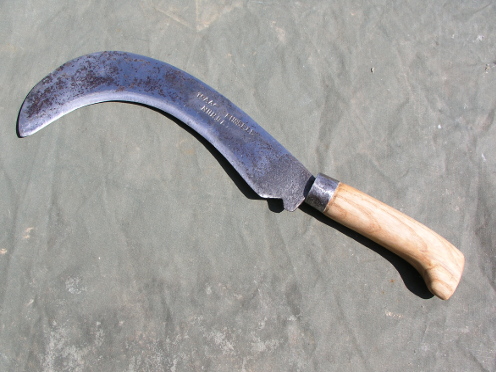
Isaac Fussell, Nunney, Somerset. Another product of the Fussell tribe. Wrought iron with applied steel bit. Nice bold maker's mark, probably mid Victorian.
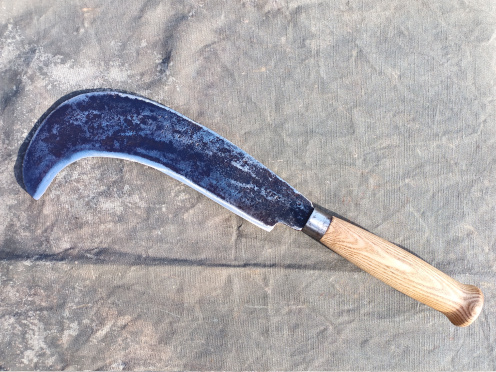
Robert Coombs at Doulting, near Shepton Mallet, Somerset. Billhook, marked "COOMBS" with serifs.
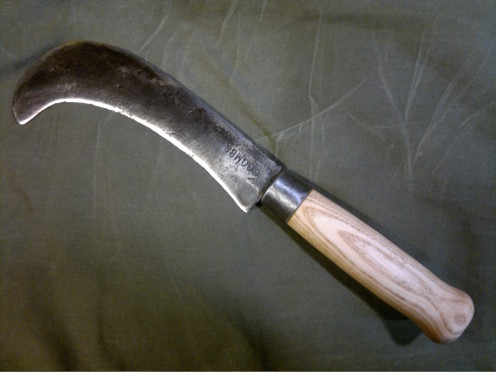
Robert Coombs at Doulting, near Shepton Mallet, Somerset. Spar hook, marked "COOMBS" without serifs - the mark is upside down.
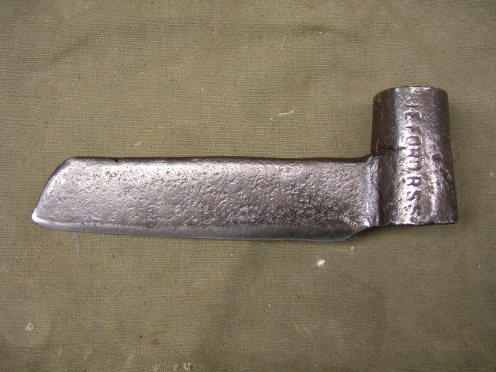
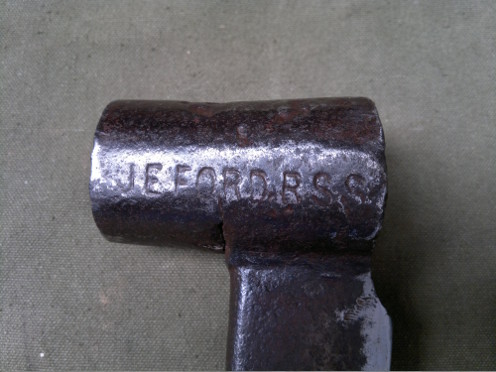
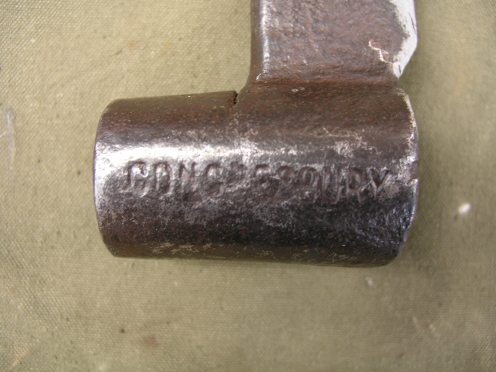
Froe made by James Edward Ford, Congresbury, Somerset. This tool is unusually well marked:- "J E FORD RSS" and "CONGRESBURY". RSS is Registered Shoeing Smith. Date, probably early 1900s. The Fords had a forge in Brinsea Road up until the 1960s. Congresbury History Group, ...scroll down to page 14 for a picture inside the forge.
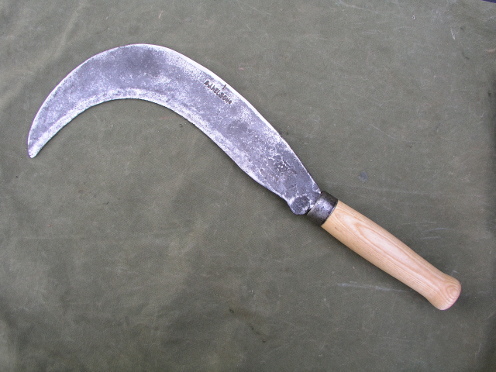
J. Helson, Dunsford, Devon. The Helsons ran Dunsford forge before the Morris family took it over, and J. Helson was the son of the original encumbent, so I would date this tool roughly to the end of the 19th C. A very pronounced nose on this billhook, and looks awkward, but this tool was most probably intended for faggoting work, i.e. trimming and gathering into bundles twiggy material for fuel (as used in a baker's oven) - hence the term Fuel Hook as seen in old catalogues like Knapman's.
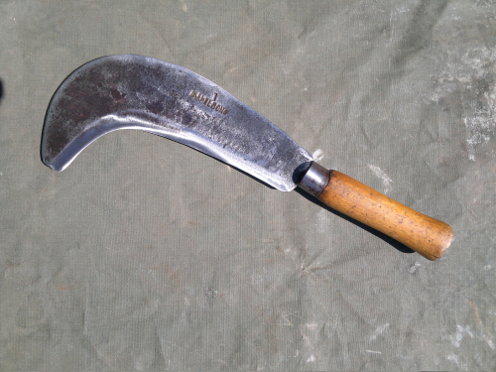
J. Helson, Dunsford, Devon. Spar hook, old and possibly original handle.
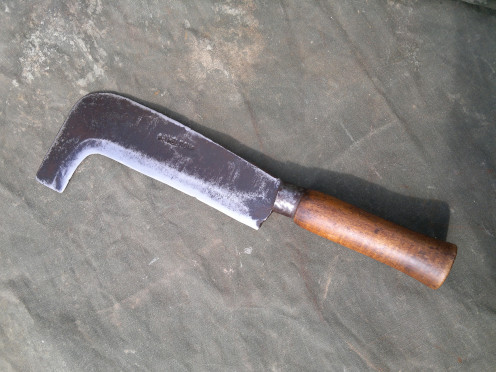
J. Helson, Dunsford, Devon. Patch hook, handle similar to the tool shown above, and so possibly original.
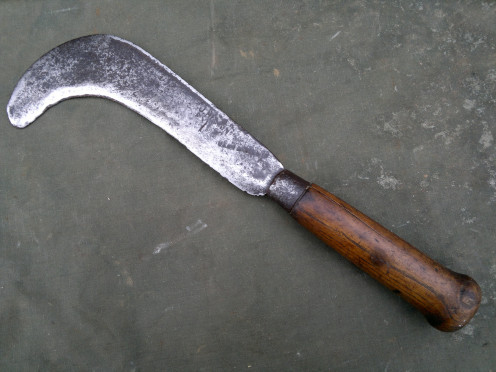
J. Helson, Dunsford, Devon. Small spar hook, old and probably original handle.
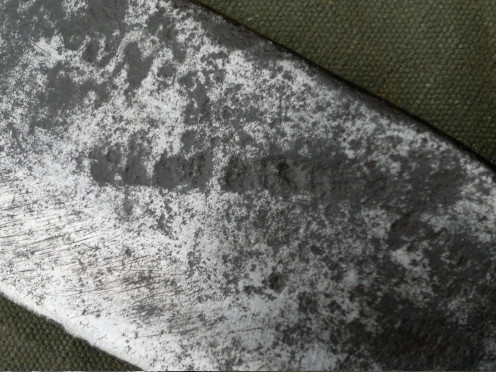
Faint text on the small Helson spar, possibly "cast steel"?.
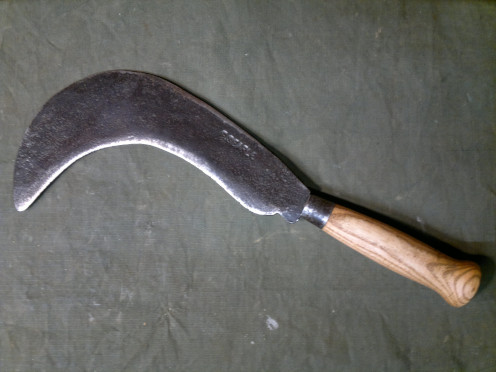
Very probably George Searle, of 36 South Street, South Molton, Devon, although I have yet to see another tool with this mark, and Searle is not an uncommon name among blacksmiths in the South West, it seems.
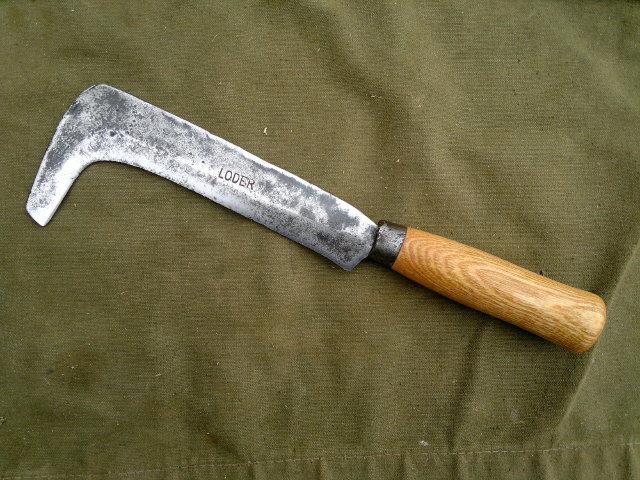
Frederick George Loder, Holbeam Works, West Ogwell, Devon. A tool probably dating from 1920s, although Frederick's father John was working at the forge in the late 19th C. This hook has a lovely shape, very distinctive. When found it still had a very decayed handle attached, looking/feeling like willow - see below.
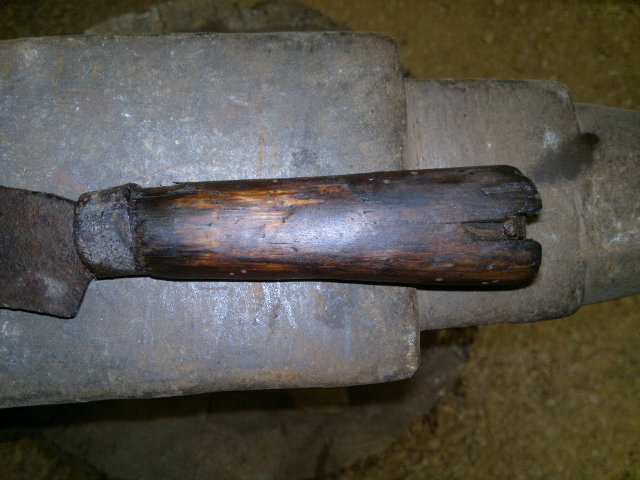
Loder sparhook handle, as found.
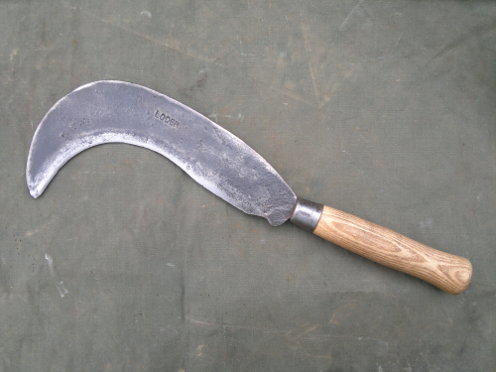
Frederick George Loder, Holbeam Works, West Ogwell, Devon. Loder billhook.
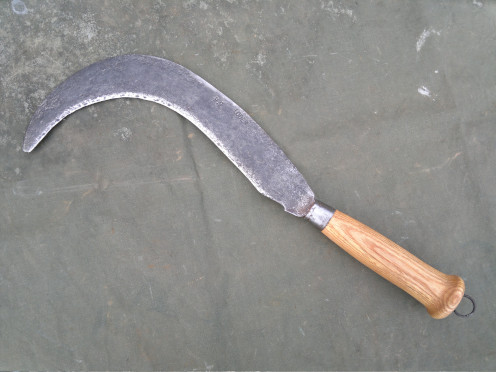
Loder, Holbeam Works, West Ogwell, Devon. A fuel or faggoting hook...
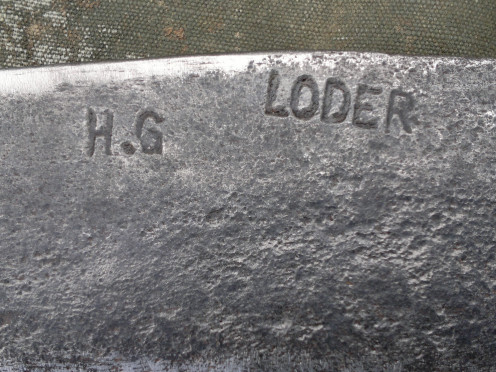
... with additional H.G marking.
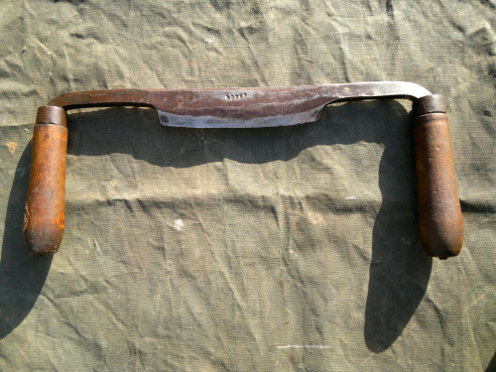
Loder, Holbeam Works, West Ogwell, Devon. A nicely forged drawknife, blade length about 6", stamped LODER in small letters with serifs.
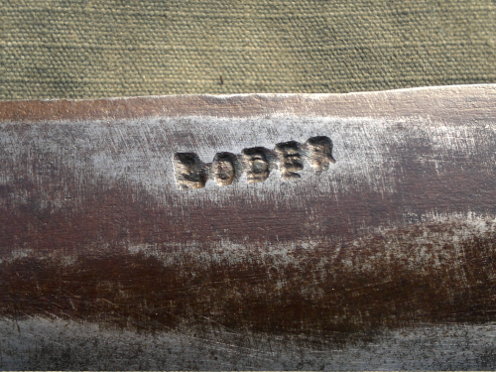
Stamp on drawknife, about 3/4" in length.
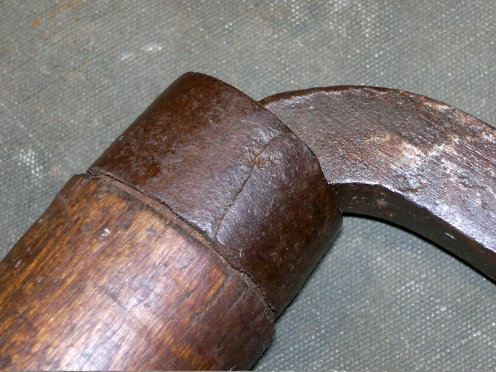
The handles appear to be original, with forge welded ferrules.

Finch Bros, Sticklepath, Devon. Finch Brothers ran the Finch "Foundry" in Sticklepath, making edge tools and mining equipment. No foundry work was carried out there (certainly in latter years) as far as I know - this was a forge. You can visit the site, as it is preserved by the National Trust. This tool is a Browse or Trimming type hook, with a ring at the end of the tang.
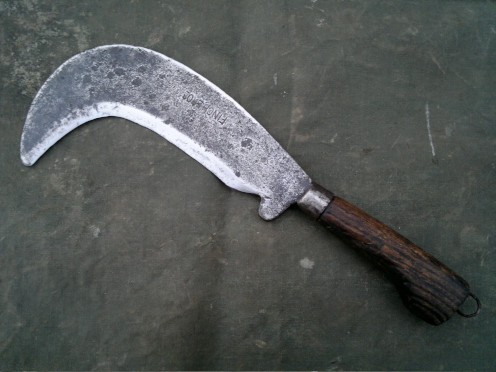
Finch Bros. 9" Finch billhook."
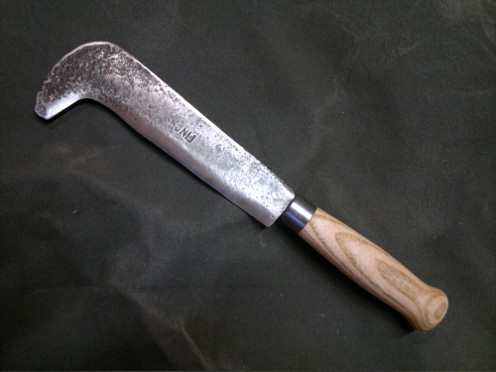
Finch Bros. Spear (or Spar) Hook. Finch's catalogue refers to this as a Spear Hook, Spar Hook is a more common term, but I've also seen them described as a Spit Hook. Whatever the name, the most common use would be preparing thatching spars from cleft hazel.
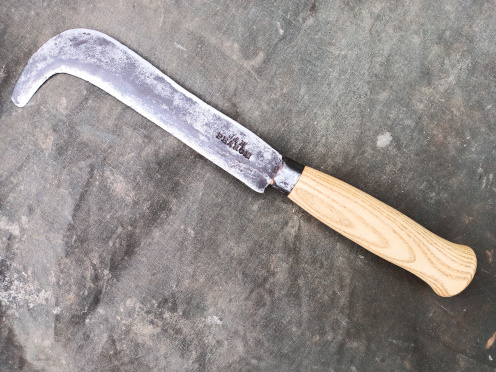
J & H Pearce Spar Hook. Thought to be made by (or for) James and Henry Pearce, Tavy Foundry, Tavististock, Devon, mid 1800s. Other foundrys in Tavistock made edge tools, so it may be reasonable to suppose Pearce did too - but I have no definite proof.
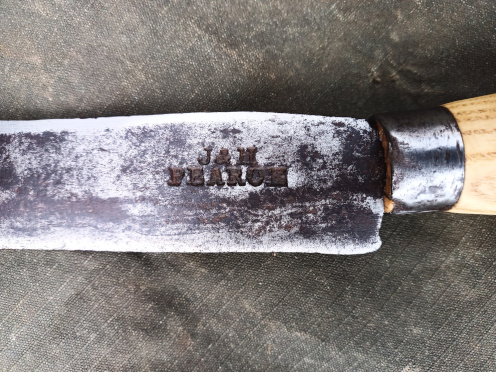
J & H Pearce Spar hook mark closeup.
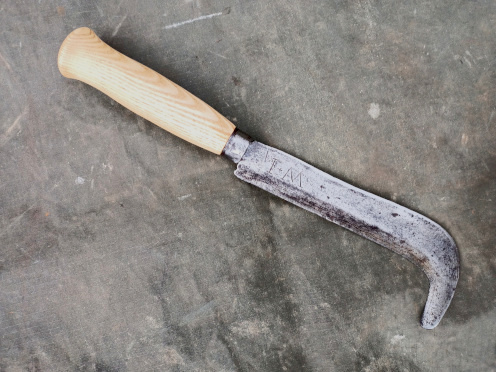
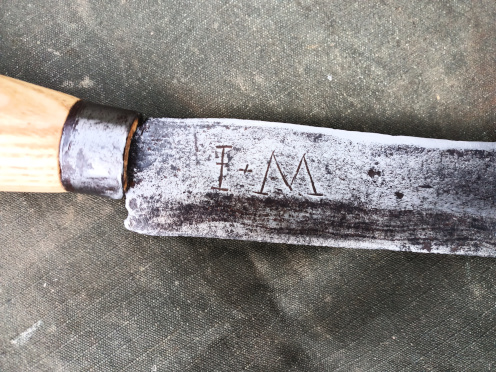
J & H Pearce Spar hook rear of blade, showing an archaic looking I+M mark, presumably initials of the owner. "I" maybe standing for "J", as they were used with a degree of interchangeability long after J was introduced to the alphabet. Initials applied with hand tools (i.e. a chisel) are particularly prone to this, as straight lines are much easier to carve or cut!
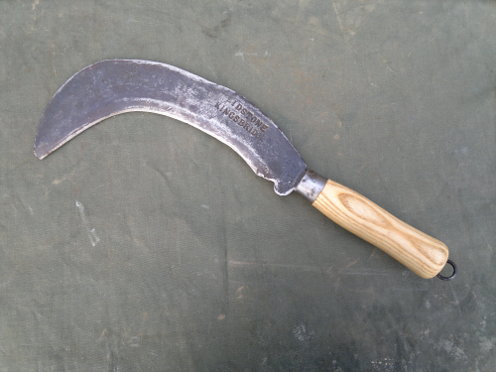
Lidstone, Kingsbridge, Devon. A small hook at about 9". Probably mid to late 19thC, but could concievably be earlier, given that Lidstone's had been on the same site for 100 years in 1874! To quote Kingsbridge And Its Surroundings, 2nd Edition 1874:-
"In Duke Street is situated Lidstone's iron foundry, which it seems, is in Kingsbridge; but as the stream which divides the parishes is underneath Duke Street, it is not easy to discover to which some of the houses belong. Mr. Lidstone's foundry stands on the site occupied by the same business in possession of the same family for more than a century. The blacksmith's department was first founded, but has been gradually increased and added to, and at present iron-founding, smithery, and practical engineering are all carried on, with the assistance of the varied appliances of modern machinery, turning lathes, iron planing machines, boring and punching machines, all of which are worked by steam. All kinds of edge tools, agricultural machines, and implements,as well as steam engines, are manufactured on the premises. Salcombe being the nearest port to the Channel Islands, a large trade (principally in edge tools) is carried on with them, in connection with the fisheries of Newfoundland and Labrador, and there is also a considerable amount of business with the whole of the South Hams."
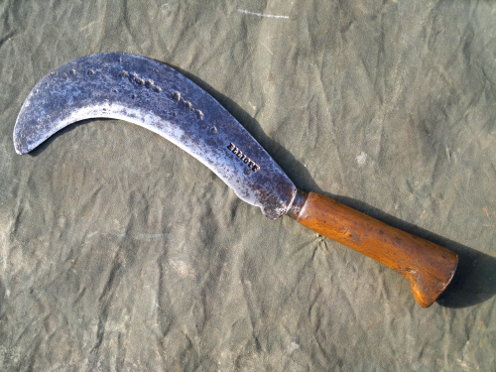
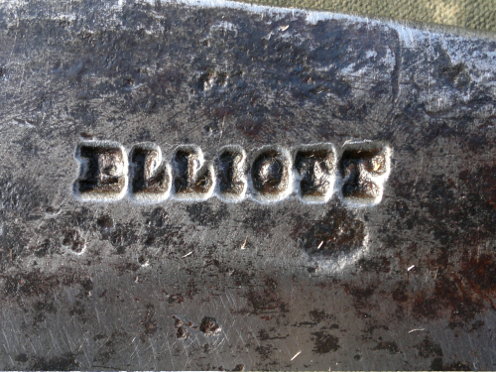
Robert Elliott, Hill Mill, Harberton, Totnes, Devon. Made by Robert Elliott Snr. or Jnr., most likely in the 1830s or 40s - the Elliotts preceeded Knapman at Hill Mill. The tool is wrought iron, steel bitted, and has an old (but almost certainly non original) willow handle.
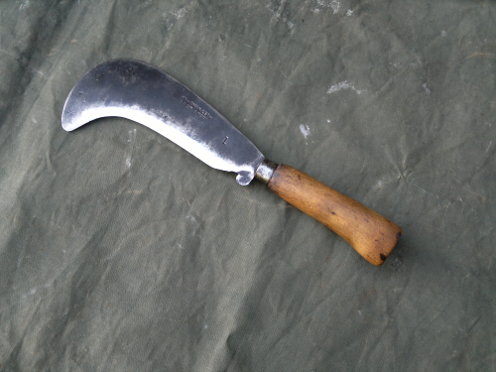
Knapman & Son, Totnes, Devon. No1. Small billhook - possibly a Dorset Wood Hook according to the early 20thC catalogue - 8" blade. Unusual as it seems to have its original handle. Knapman of Hill Mill, Harberton near Totnes, closed in 1954.
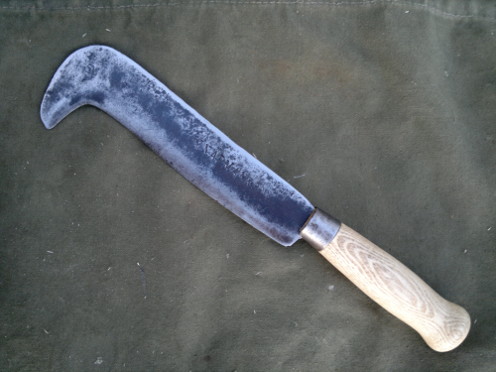
Knapman & Son, Totnes, Devon. Spear or spar hook Late 19th C. probably:- large lettering with serifs, no marking of "Best Steel".
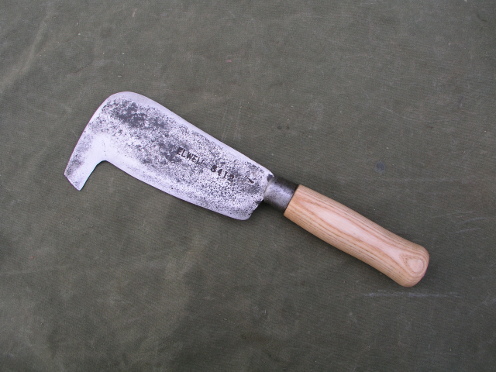
Elwell 3412 Patch Hook. Of course the big manufacturers from the Midlands catered for the South West tool buyers too. This is a Devon Patch Hook, made by Elwell of Wednesbury. It is a broad bladed spar type hook with a blunt ended beak - what its traditional use was, I'm not sure - doesn't look ideal for spar making.
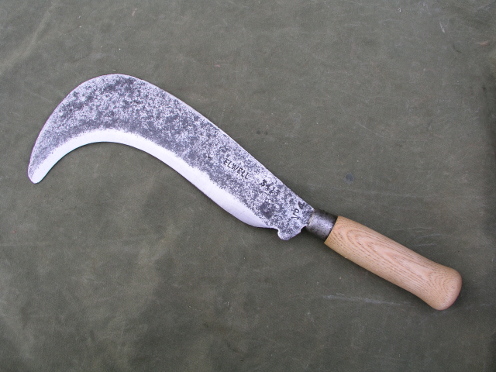
Elwell 3413 Devon Billhook size No4. This is Elwell's version of a Devon billhook, and is nicely balanced. Number 4 is the largest size at 10&1/4": for some reason these ran as No1: 8&3/4", No2: 9&1/4", No3: 9&3/4". Later on Elwell deleted this pattern, and made the 4583 Devon, and with a caulked handle rather than the round type, and in rationalised sizes of 8,9,10 and 11".
For useful information on regional tool makers see A Load of Old Billhooks
If you have information or memories about edge tool makers in South West England I'd be delighted to hear from you!
Contact me by email.
See also: photos of billhooks made by manufacturers in the Midlands and photos of handbills made by edge tool makers in the Weald.
© Ian Swain 2025